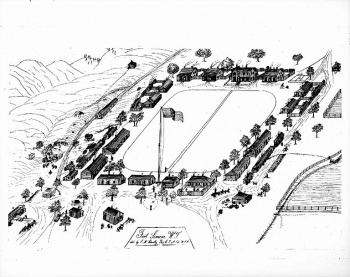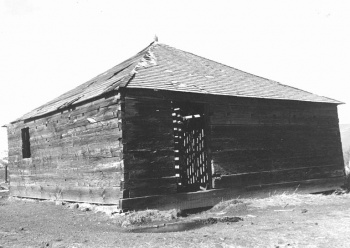Fort Simcoe: Difference between revisions
Bill Thayer (talk | contribs) new URL for that page (link rot fix) |
John Stanton (talk | contribs) No edit summary |
||
| Line 21: | Line 21: | ||
| | | | ||
<googlemap version="0.9" lat="46.342765" lon="-120.837958" zoom="16" width="500" scale="yes" overview="yes" controls="large" icons="http://www.fortwiki.com/mapicons/icon{label}.png"> | <googlemap version="0.9" lat="46.342765" lon="-120.837958" zoom="16" width="500" scale="yes" overview="yes" controls="large" icons="http://www.fortwiki.com/mapicons/icon{label}.png"> | ||
(F) 46. | (F) 46.34277, -120.83796, Fort Simcoe | ||
(1856-1859) | (1856-1859) | ||
</googlemap> | </googlemap> | ||
| Line 28: | Line 28: | ||
White Swan, Yakima Indian Reservation, Washington (30 miles west of Toppenish, Yakima County, Washington) | White Swan, Yakima Indian Reservation, Washington (30 miles west of Toppenish, Yakima County, Washington) | ||
{{Mapit-US-cityscale|46. | {{Mapit-US-cityscale|46.34277|-120.83796}} | ||
* Elevation: 1,401' | * Elevation: 1,401' | ||
|} | |} | ||
Revision as of 12:48, 22 August 2016
|
Fort Simcoe (1856-1859) - Established on 8 Aug 1856 by Major Robert Seldon Garnett and Companies G and F of the 9th U.S. Infantry Regiment. The fort was located at the "bubbling spring" on Toppenish Creek near the site of Haller's defeat, Yakima County, Washington. Major Garnett was the first commander at Fort Simcoe.
Fort Simcoe HistoryFort Simcoe was designed by architect Louis Scholl who also designed Fort Dalles. It had a blockhouses at each corner of the post but no stockade, each blockhouse was a standalone fortification. A 420' square parade ground was surrounded by log and frame barracks and service buildings within the boundaries defined by the blockhouses. The fort was used as the Yakima Indian Agency beginning in 1859 after the garrison transferred to Fort Colville. It was abandoned in 1923. The state leased the state park property from the Yakima Nation in 1953. The fort has been restored and contains three officers quarters (1857 - 1858), one of four original blockhouses (1856), and the Commandant's House (1857 - 1858).
Current StatusIn 1956, Fort Simcoe became a state park, and in 1974 it was added to the National Register of Historic Places.
Sources:
Links: Visited: No | ||||||||||||||||||||||||||||||||||||||||||


